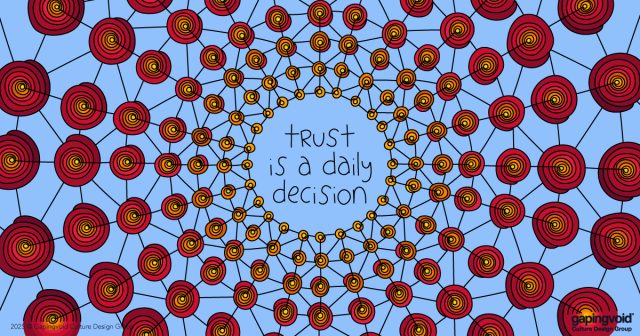
Here in South Florida where Gapingvoid is based, we just survived another Hurricane season.
Watching a few hurricanes nearly miss us naturally led us to think about organizational communication. Clearly, there’s a correlation. Right?
What struck us is that most executives, irrespective of industry or sector, treat communications like UberEats; sending fully baked information from point A to point B as a necessary transaction. But that reduces a hurricane warning system to “it might rain tomorrow.” While internal comms teams spend hours crafting top down messages, often they die quiet deaths in people’s inboxes. Unread. Unwanted. This reinforces the fact that comms teams are often treated as a mere delivery system.
The reality is that comms, well-executed, are your organization’s central nervous system. It’s how we create alignment, signal progress, surface setbacks, and focus attention on what matters most. It’s how we create a shared reality that moves people to action.
Think about how hurricane communications work:
- Monday: “Tropical depression forming” = heads up
- Wednesday: “Tropical storm intensifying” = time to pay attention
- Thursday: “Category 1 hurricane approaching” = start getting serious
- Friday: “Now a Category 3 hurricane” = get your sh*t together NOW
We track the progress. We watch the weather updates. We’re in alert and sensing mode. With each update, behavior shifts. When the storm is approaching no one is saying, “I didn’t know,” people are buying bottled water and running to Costco for canned goods.
If at some point, it turns to a category 2, or heaven forbid, a 3, 4, or 5, we’re tracking hourly. Adjusting our actions accordingly. All eyes are on the storm.
Weather forecasters understand something most of us overlook. They know that awareness builds gradually and different people tune in at different times. They don’t care if they’re repeating themselves. They know that repetition isn’t redundant – it’s necessary. They don’t care about looking important. They’re trying to keep people alive.
Great organizational communication follows the same pattern. It’s persistent, consistent, and gradually intensifies. It treats every step as part of a larger story that’s unfolding. Leaders who communicate effectively know that it’s not about ego, it’s about keeping your organization alive. And that’s not hyperbole.
Most organizations send occasional memos and then wonder why nobody is boarding up their windows or why half the team is saying, they didn’t know there’s a hurricane.
The organizations that are household names treat comms like hurricane warnings. Consistent. Clear. Escalating. REAL.
Pick your approach. There’s always a storm coming.



